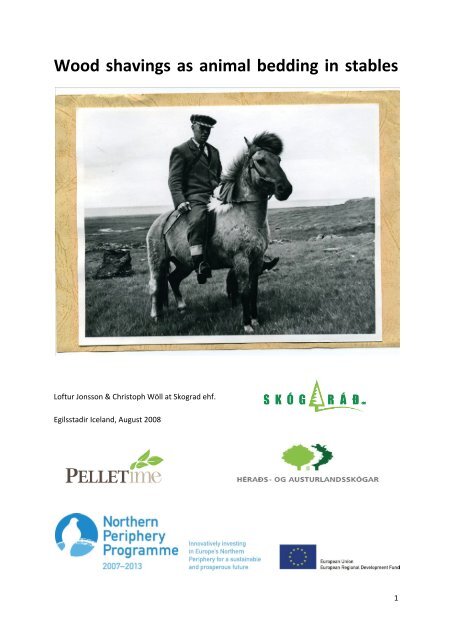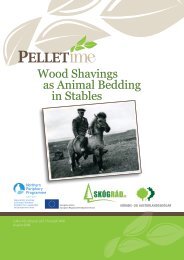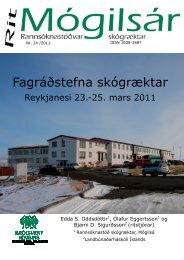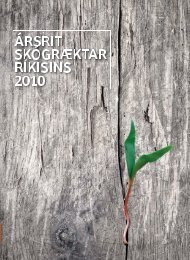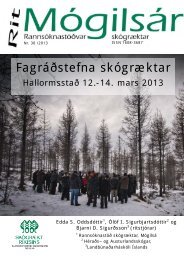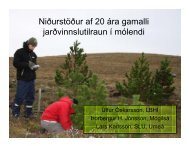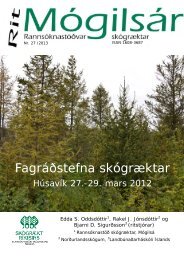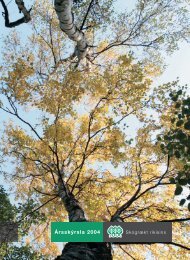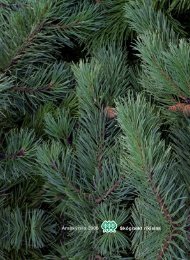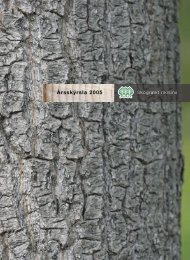Wood shavings as animal bedding in stables
Wood shavings as animal bedding in stables
Wood shavings as animal bedding in stables
Create successful ePaper yourself
Turn your PDF publications into a flip-book with our unique Google optimized e-Paper software.
<strong>Wood</strong> <strong>shav<strong>in</strong>gs</strong> <strong>as</strong> <strong>animal</strong> <strong>bedd<strong>in</strong>g</strong> <strong>in</strong> <strong>stables</strong>Loftur Jonsson & Christoph Wöll at Skograd ehf.Egilsstadir Iceland, August 20081
ContentsIntroduction ............................................................................................................................................. 3Bedd<strong>in</strong>g <strong>in</strong> <strong>stables</strong> ................................................................................................................................... 4<strong>Wood</strong> products <strong>as</strong> <strong>bedd<strong>in</strong>g</strong> ..................................................................................................................... 5Products and producers .......................................................................................................................... 6<strong>Wood</strong> shav<strong>in</strong>g mills ................................................................................................................................. 9Dry<strong>in</strong>g equipment, high temperature dryers ........................................................................................ 11Low temperature dry<strong>in</strong>g ........................................................................................................................ 12Hestalist ehf ........................................................................................................................................... 14Conclusion ............................................................................................................................................. 16Sources: ................................................................................................................................................. 182
IntroductionThis paper is written for the “Herad & Austurlandsskogar” reforestation project <strong>in</strong> the e<strong>as</strong>t ofIceland.The reforestation project consists of 140 private landowners who have been plant<strong>in</strong>gcommercial timber forests s<strong>in</strong>ce 1990. As the earlier plantations are now enter<strong>in</strong>g the first th<strong>in</strong>n<strong>in</strong>gstage, the project is now concerned with market<strong>in</strong>g its timber products, especially low grade timberfrom first th<strong>in</strong>n<strong>in</strong>g.In order to do so, Heradsskogar h<strong>as</strong> jo<strong>in</strong>ed forces with other Europeanorganizations under the auspices of the EU‐funded NPP (Northern Periphery Projects).The purpose of this paper is to <strong>in</strong>vestigate the production of <strong>animal</strong> <strong>bedd<strong>in</strong>g</strong> <strong>as</strong> a potential market fordomestic timber <strong>in</strong> Iceland; to get an overview of products, production technology and the market <strong>in</strong>Iceland.3
Bedd<strong>in</strong>g <strong>in</strong> <strong>stables</strong>Bedd<strong>in</strong>g denotes any material strewn <strong>in</strong> an <strong>animal</strong>'s enclosure (e.g. a stable).Bedd<strong>in</strong>g should havecerta<strong>in</strong> properties. The <strong>bedd<strong>in</strong>g</strong> material should have a high absorbency of the <strong>animal</strong>´s ur<strong>in</strong>e. Asimplied by the word, <strong>bedd<strong>in</strong>g</strong> should also provide for a soft bed to prevent the <strong>animal</strong> from gett<strong>in</strong>gbedsores. More functions of <strong>bedd<strong>in</strong>g</strong> are to isolate downwardly and to provide a nonslip ground forthe horse to stand on. The <strong>bedd<strong>in</strong>g</strong> should not conta<strong>in</strong> harmful substances. To some extent dust canbe harmful to the <strong>animal</strong> respiratory system, <strong>as</strong> well <strong>as</strong> mould, which can cause allergies. Sharpitems can cause trouble for bigger <strong>animal</strong>s. The most common <strong>bedd<strong>in</strong>g</strong> <strong>in</strong> <strong>stables</strong> is straw. Althoughregarded <strong>as</strong> “the most natural <strong>bedd<strong>in</strong>g</strong>” by many farmers, it h<strong>as</strong> certa<strong>in</strong> disadvantages. Itsabsorbency of 200 % (compared with dry matter) is moderate compared with other materials andur<strong>in</strong>e is dra<strong>in</strong>ed rather than absorbed. The <strong>animal</strong>s may also eat the straw, which often conta<strong>in</strong>sfungal spores and which, blended with excretions, often causes colic. Additionally, straw oftenconta<strong>in</strong>s a great deal of dust and needs a lot of storage space.4
<strong>Wood</strong> products <strong>as</strong> <strong>bedd<strong>in</strong>g</strong>Because of the shortcom<strong>in</strong>gs of straw, horse owners have looked for better <strong>bedd<strong>in</strong>g</strong> materials. <strong>Wood</strong>products are the most common <strong>bedd<strong>in</strong>g</strong> alternatives to straw, <strong>in</strong>clud<strong>in</strong>g sawdust, wood <strong>shav<strong>in</strong>gs</strong> andgranulated wood <strong>shav<strong>in</strong>gs</strong>. Sawdust can generally be obta<strong>in</strong>ed from sawmills, where<strong>as</strong> wood<strong>shav<strong>in</strong>gs</strong> and their granulated form are delivered from producers <strong>in</strong> bales. What is important for allthree products is that they orig<strong>in</strong>ate from untreated wood. The ma<strong>in</strong> re<strong>as</strong>on for the use of wood<strong>bedd<strong>in</strong>g</strong> is that the majority of horses <strong>in</strong> <strong>stables</strong> have allergies stemm<strong>in</strong>g from fungal spores andbacteria <strong>in</strong> straw <strong>bedd<strong>in</strong>g</strong>. While sawdust still conta<strong>in</strong>s a lot of dust, dust extracted wood <strong>shav<strong>in</strong>gs</strong>are suitable for horses with respiratory problems. They also have a higher absorbency than straw,rang<strong>in</strong>g from 260% to 420%. In granulated form wood <strong>shav<strong>in</strong>gs</strong> can absorb even more liquid. Forsawdust and wood <strong>shav<strong>in</strong>gs</strong> there are additions available which conta<strong>in</strong> enzymes and bacteria thatfeed on ammonia: thus, the wet spots do not have to be removed but can stay where they are,because the bacteria b<strong>in</strong>d the potentially harmful ammonia.5
Products and producersThe Austrian company Johann Pabst Holz<strong>in</strong>dustrie GmbH produces two different <strong>bedd<strong>in</strong>g</strong>s:AlpenSpan and AlpenSpan exquisite. Both are made of dedusted spruce <strong>shav<strong>in</strong>gs</strong> and conta<strong>in</strong> noadditives (Fig. 1 and Table 1). In the stable AlpenSpan is used <strong>in</strong> the follow<strong>in</strong>g way: several bales areused to cover the previously cleaned ground; horse dropp<strong>in</strong>gs and wet places have to be removeddaily and the removed <strong>bedd<strong>in</strong>g</strong> h<strong>as</strong> to be replaced. The complete <strong>bedd<strong>in</strong>g</strong> h<strong>as</strong> to be removed afterthree months. The second product, AlpenSpan exquisite, is enriched with enzymes and bacteria. Theenzymes b<strong>in</strong>d ammonia, keep<strong>in</strong>g it from escap<strong>in</strong>g <strong>in</strong>to the air. Thus the <strong>bedd<strong>in</strong>g</strong> h<strong>as</strong> to be removedonly twice a year and constitutes a good fertilizer afterwards. Both products come precisely packed<strong>in</strong> heat‐sealed bags, and are delivered on wrapped Euro‐Pallets, which require little storage space.Table 1. Technical data for AlpenSpan and AlpenSpan exquisite <strong>bedd<strong>in</strong>g</strong> by the Johann PabstHolz<strong>in</strong>dustrie GmbH.AlpenspanAlpenspan exquisiteBag size <strong>in</strong> cm 80x40x40 80x40x40Weight 20.5 kg 20 kgPackag<strong>in</strong>g volume 120 l 120 lScatter<strong>in</strong>g volume 430 l 500 lWater content Max. 11 % Max. 11 %Consumption per horse per week Approx. 1,5 bales Approx. 1 balepH value of the dung 7.8 7.8Used raw material Untreated spruce Untreated spruceAbsorb<strong>in</strong>g capacity M<strong>in</strong>. 300 % M<strong>in</strong>. 300 %Nitrogen Max 0.3 % Max 0.3 %Factory price per bale 5,40 € 7,20 €Fig. 1 & 2. AlpenSpan bales and the mach<strong>in</strong>e used to shave the wood.6
<strong>Wood</strong> shav<strong>in</strong>g millsFor production of wood <strong>shav<strong>in</strong>gs</strong> there is a range of different mach<strong>in</strong>ery and technology on themarket. Some of the bigger ones can even produce <strong>shav<strong>in</strong>gs</strong> from coarsed chips. The technicalpr<strong>in</strong>ciple for a small‐scale shav<strong>in</strong>g mill is simple. A hydraulic arm moves a planer (which can havemany blades) back and forth, shav<strong>in</strong>g the round wood to the desired thickness. Alternatively theblade is bolted, where the wood is moved back and forth over it, giv<strong>in</strong>g the same result. The<strong>shav<strong>in</strong>gs</strong> are usually fed <strong>in</strong>to a hammer‐mill unit to break the <strong>shav<strong>in</strong>gs</strong> <strong>in</strong>to the desired size beforedry<strong>in</strong>g.Jackson Lumber Harvester Co., Inc., b<strong>as</strong>ed <strong>in</strong> Wiscons<strong>in</strong> produces wood shav<strong>in</strong>g mills of differentsizes. The technical data for the smaller mach<strong>in</strong>es can be seen <strong>in</strong> table 2 and a picture of a shav<strong>in</strong>gmill <strong>in</strong> figure 9.Table 2. Technical data for wood shav<strong>in</strong>g mills by Jackson Lumber9
Fig. 9 <strong>Wood</strong> shav<strong>in</strong>g mill by Jackson Lumber Harvester Co., Inc.In Germany the company Hombak also produces shav<strong>in</strong>g mills of different sizes. Among them is oneshav<strong>in</strong>g mill constructed especially for <strong>animal</strong> <strong>bedd<strong>in</strong>g</strong>. The smallest version weighs 29 tons andprocesses up to 6 t dry matter per hour, and thus might be too big for Iceland. The companyproduces another much smaller shav<strong>in</strong>g mill, called ZOA 18, not especially for <strong>animal</strong> <strong>bedd<strong>in</strong>g</strong>s,though.10
Dry<strong>in</strong>g equipment, high temperature dryersAs mentioned earlier, the <strong>shav<strong>in</strong>gs</strong> have to be dried before they can suit their purpose. There is a v<strong>as</strong>tarray of dryers, but most shav<strong>in</strong>g equipment producers recommend the use of rotary drum dryers forlight materials like <strong>shav<strong>in</strong>gs</strong>. The most common drum dryers are simple p<strong>as</strong>s and triple p<strong>as</strong>s drumdryers. Simple p<strong>as</strong>s drum dryers consist of a rotat<strong>in</strong>g horizontal drum of vary<strong>in</strong>g length and diameter(lengths vary from 4 to 12 m and diameters from 1 to 3 m). The drum rotates with 1 to 5 rotationsper m<strong>in</strong>ute and exhaust fumes from a connected fir<strong>in</strong>g are led through the drum. The <strong>shav<strong>in</strong>gs</strong> enterthe slightly <strong>in</strong>cl<strong>in</strong>ed drum through a paddle and stay <strong>in</strong>side for app. 20 to 30 m<strong>in</strong>utes. The <strong>shav<strong>in</strong>gs</strong>are constantly lifted by shovels and the construction form of the drum provides that the bigger<strong>shav<strong>in</strong>gs</strong> stay longer <strong>in</strong>side the drum. The dry<strong>in</strong>g takes place by convective heat transfer and theheated drum parts.The triple p<strong>as</strong>s drum dryer is most suitable for very light materials. The difference to the simple p<strong>as</strong>sdryer is that the triple p<strong>as</strong>s dryer consists of three concentric cyl<strong>in</strong>ders, which are mechanically<strong>in</strong>terlocked to rotate at the same speed (see Fig. 8 and 9). The <strong>shav<strong>in</strong>gs</strong> are repeatedly carried to thetop of each cyl<strong>in</strong>der by <strong>in</strong>ternal and external flights so they are constantly showered through the hotg<strong>as</strong>. Moisture is given off cont<strong>in</strong>ually <strong>as</strong> they move along the hot air stream. Heavier, wetter particlesmove slower than f<strong>in</strong>e particles forward through the center cyl<strong>in</strong>der (red), back through the<strong>in</strong>termediate cyl<strong>in</strong>der (orange) and aga<strong>in</strong> forward through the outer cyl<strong>in</strong>der (blue) to the fan at thedischarge end. The warm damp exhaust g<strong>as</strong>es are separated from the dried product <strong>in</strong> the primarycyclone collector, and fall out the bottom onto a shaker screen to remove f<strong>in</strong>es.Fig. 10 & 11. Triple‐p<strong>as</strong>s drum dryer11
There are a big number of producers of drum dryers both <strong>in</strong> Europe and <strong>in</strong> North America.Table 3. Producers of drum dryersProducer Country RemarkAllgaier Werke GmbH Germany Also sells used equipmentStela Laxhuber GmbH GermanyDieffenbacher group GermanyOnix corporation U.S. Also sells used equipment, h<strong>as</strong> dryers <strong>in</strong> many differentsizes and their homepage features a tool to calculate theright size for <strong>in</strong>dividual purposesEnergy unlimited U.S. Also sells used equipment and sawdust burnersJackson lumber U.S. Also sells used equipment and suit<strong>in</strong>g burnersharvester wood shav<strong>in</strong>gmillsAaron equipment U.S. Is a market for used equipment, offer<strong>in</strong>g 20 used drumcompanydryers at the time of writ<strong>in</strong>gLow temperature dry<strong>in</strong>gDry<strong>in</strong>g of <strong>shav<strong>in</strong>gs</strong> normally takes place at temperatures above 100 °C. The higher the dry<strong>in</strong>gtemperature the f<strong>as</strong>ter and more energy consum<strong>in</strong>g the dry<strong>in</strong>g process. Medium sized wood<strong>shav<strong>in</strong>gs</strong> <strong>in</strong> a dryer work<strong>in</strong>g with 200 °C are dry (moisture content below 11 %) after app. 30 m<strong>in</strong>utes.Nevertheless <strong>shav<strong>in</strong>gs</strong> can be dried at temperatures below boil<strong>in</strong>g po<strong>in</strong>t. Besides less energyconsumption, dry<strong>in</strong>g with lower g<strong>as</strong> temperatures h<strong>as</strong> the advantage that no hydrocarbons or otherchemical contam<strong>in</strong>ants are rele<strong>as</strong>ed dur<strong>in</strong>g the dry<strong>in</strong>g process. The Swedish company SvenskRökg<strong>as</strong>energi AB (SRE) produces a dryer for wood <strong>shav<strong>in</strong>gs</strong> that operates with 70 °C hot air (Fig. 10).The Renergi LTK Dryer is b<strong>as</strong>ed on the counter‐flow pr<strong>in</strong>ciple. Material is fed from the top of thedryer and removed at the bottom, while the air <strong>in</strong>take is at the bottom, mean<strong>in</strong>g that the air isp<strong>as</strong>sed aga<strong>in</strong>st the material flow, thus achiev<strong>in</strong>g a high degree of efficiency <strong>in</strong> the dry<strong>in</strong>g process (Fig.11). Often the Renergi LTK Dryer is <strong>in</strong>stalled together with a conventional drum dryer (the energyrichg<strong>as</strong> from the drum dryer is fed to a condenser, which reclaims heat that is transferred via an airbattery to the fresh air, which reaches a temperature of about 70°C; the now dry and heated air isused <strong>in</strong> the Renergi LTK Dryer) <strong>in</strong> order to <strong>in</strong>cre<strong>as</strong>e productivity or save energy. The Renergi LTK dryercan also be used without a drum dryer. The b<strong>as</strong>ic configuration of this sett<strong>in</strong>g is shown <strong>in</strong> Fig. 12. The12
dryer is often run with w<strong>as</strong>te energy from conventional dry<strong>in</strong>g processes or the energy content found<strong>in</strong> flue g<strong>as</strong>es from bio‐fueled boilers.Fig. 12 & 13. Renergi LTK dryerFig. 14. B<strong>as</strong>ic configuration of dry<strong>in</strong>g with Renergi LTK dryer. Input is wet material and hot dry g<strong>as</strong>,output is dried material and energy rich wet g<strong>as</strong>.13
Hestalist ehfIn Mosfellsbær, the company Hestalistehf produces wood <strong>shav<strong>in</strong>gs</strong> <strong>as</strong> <strong>bedd<strong>in</strong>g</strong>for chicken and horse farms. When thecompany w<strong>as</strong> started <strong>in</strong> 2000, the rawmaterial for the <strong>bedd<strong>in</strong>g</strong> consisted ma<strong>in</strong>ly<strong>in</strong> scrap from carpenters and DIY stores(=<strong>shav<strong>in</strong>gs</strong> and sawdust). Though stillused dur<strong>in</strong>g summer, when the demandFig. 15. Lumber Jack planer at Hestalistfor <strong>bedd<strong>in</strong>g</strong> is smaller, <strong>as</strong> most horses aregraz<strong>in</strong>g outdoors, scrap is not the ma<strong>in</strong>raw material source anymore. The re<strong>as</strong>on for the reduction of the scrap share is that big suppliers ofit, e.g. Byko, moved their production abroad. For the shav<strong>in</strong>g‐mach<strong>in</strong>e, the raw material can b<strong>as</strong>icallybe any k<strong>in</strong>d of timber that is shaveable. Dur<strong>in</strong>g w<strong>in</strong>ter, when the demand for <strong>bedd<strong>in</strong>g</strong> is higher, thecompany h<strong>as</strong> been import<strong>in</strong>g about 90 m 3 of round wood per week from Europe and Russia.Preferred tree species have been spruce and p<strong>in</strong>e. When available, cardboard is mixed with thewooden substance. The cardboard must be clean of any dirt. Therefore they only accept leftoversfrom the pack<strong>in</strong>g <strong>in</strong>dustry but not second hand cardboard from consumers. Industrial w<strong>as</strong>te timberfrom the construction <strong>in</strong>dustry cannot be used because of nails and such that will damage the bladesand be<strong>in</strong>g unwanted <strong>in</strong> the product. The <strong>shav<strong>in</strong>gs</strong> can be mixed with paper and with <strong>shav<strong>in</strong>gs</strong> andsawdust from traditional wood process<strong>in</strong>g <strong>in</strong>dustries. <strong>Wood</strong> chips would probably not work <strong>in</strong> theHestalist product process, but h<strong>as</strong> <strong>as</strong> yet not been tried. Except for occ<strong>as</strong>ionally cardboards, no othersubstances are added to Hestalist product.At arrival logs are cut to length at the factory. For the plann<strong>in</strong>g mach<strong>in</strong>e logs can be at maximum 1.3m long. The logs are then manually laid <strong>in</strong> the planer one by one. The planer (a lumber jack,electrical unit) h<strong>as</strong> 6 blades and can process 30 m 3per 12 hour shift. On average it can run 30 hoursbetween sharpen<strong>in</strong>g the blades, but this dependson the raw material. If it is dry it wears the bladesmore, thus they have to be sharpened more often.Wet material is better for the blades, but theFig. 16. Raw material from Icelandic forestdisadvantage is that it requires more energy <strong>in</strong> thedry<strong>in</strong>g process. The <strong>shav<strong>in</strong>gs</strong> leav<strong>in</strong>g the planerhave an approximately palm sized area but are only 1 to 2 mm thick. Mov<strong>in</strong>g on a conveyor belt the14
strands enter a hammer<strong>in</strong>g unit where they are chopped <strong>in</strong>to smaller bits. For chicken <strong>bedd<strong>in</strong>g</strong> the<strong>shav<strong>in</strong>gs</strong> can be larger, where<strong>as</strong> for horse <strong>bedd<strong>in</strong>g</strong> they have to be f<strong>in</strong>er.After the hammer<strong>in</strong>g unit, the <strong>shav<strong>in</strong>gs</strong> enter an oil fired triple p<strong>as</strong>s drum dryer where they are driedand sterilized at 270‐300 °C (can be <strong>as</strong> high <strong>as</strong> 400 °C). The dryer w<strong>as</strong> orig<strong>in</strong>ally built for dry<strong>in</strong>g gr<strong>as</strong>spellets<strong>as</strong> livestock nutrient addition, but w<strong>as</strong> rebuilt by “Vélaverkstæði S<strong>in</strong>dra” for dry<strong>in</strong>g wood<strong>shav<strong>in</strong>gs</strong>. Dur<strong>in</strong>g the dry<strong>in</strong>g process air is abducted to keep it fromcondens<strong>in</strong>g aga<strong>in</strong>. The capacity of the dryer is twice that of the lumber‐jackplaner or 60 m 3 per 12 hour shift. Because of the rise <strong>in</strong> oil prices Hestalist<strong>in</strong>tends <strong>in</strong> near future to change the oil burner to a wood b<strong>as</strong>ed burner andthey estimate that it will <strong>in</strong>cre<strong>as</strong>e the demand for wood by about 10%. Afterleav<strong>in</strong>g the dryer the <strong>shav<strong>in</strong>gs</strong> are left to cool for at le<strong>as</strong>t a few hours beforeit is moved to the pack<strong>in</strong>g unit by a small Bob Cat. The pack<strong>in</strong>g unitcompresses the <strong>shav<strong>in</strong>gs</strong> <strong>in</strong>to a rectangular pl<strong>as</strong>tic bale, each conta<strong>in</strong><strong>in</strong>g 0.1Fig. 16. Pack<strong>in</strong>g unitm 3 and weigh<strong>in</strong>g 30 kg. The f<strong>in</strong>ished product is e<strong>as</strong>y to stack and transport.The moisture content is vary<strong>in</strong>g from 12 ‐18%.Annual production is approximately 80.000 bales pr. year and the buyers are big poultry farms(35.000 bales annually) and horse farms (35.000 bales annually) and others for other uses 10.000bales pr. year. The company estimates the domestic market to be around 200.000 ‐220.000 balesused pr. year and grow<strong>in</strong>g where<strong>as</strong> most of it is used for horse <strong>bedd<strong>in</strong>g</strong>. Their market strategy is toproduce 120.000 bales pr. year and thus dom<strong>in</strong>ate the market.Round wood imported from Europe and Russia h<strong>as</strong> been the ma<strong>in</strong> raw material dur<strong>in</strong>g the l<strong>as</strong>t years.Recently the company h<strong>as</strong> been shift<strong>in</strong>g its attention to Icelandic forests <strong>as</strong> a source of raw materialsupply. There are several re<strong>as</strong>ons for this development. One is that prices for round wood reachedhistoric heights l<strong>as</strong>t year and are likely to stay high or rise even more: Russia h<strong>as</strong> put an export tax of€15 on round wood leav<strong>in</strong>g the country and is probably go<strong>in</strong>g to raise the tax to €50, be<strong>in</strong>gtantamount to a ban on export of round wood. Add<strong>in</strong>g to the cost of imported wood is the drop <strong>in</strong>the Icelandic Crown. Another re<strong>as</strong>on for the <strong>in</strong>terest <strong>in</strong> Icelandic timber is that round wood enter<strong>in</strong>gthe country h<strong>as</strong> to be debarked, which means extra handl<strong>in</strong>g and extra cost compared to domesticraw material. The bark h<strong>as</strong> no damag<strong>in</strong>g effect on the product. And f<strong>in</strong>ally there is an argument thatus<strong>in</strong>g domestic timber enhances the image of Hestalist´s product. It is worth not<strong>in</strong>g that low gradetimber (for example from first th<strong>in</strong>n<strong>in</strong>g, small diameter and crooked form) is usable <strong>in</strong> the process.15
ConclusionThe Aim of this paper h<strong>as</strong> been to get an overview of the production, technology and market ofwood <strong>shav<strong>in</strong>gs</strong> <strong>as</strong> <strong>animal</strong> <strong>bedd<strong>in</strong>g</strong> <strong>in</strong> Iceland and raises more questions than it answers.There is clearly a market for timber (even for low grade‐ and small dimension timber) for domesticuse of <strong>animal</strong> <strong>bedd<strong>in</strong>g</strong>. Already there is one factory, Hestalist ehf, <strong>in</strong> South West Iceland that isproduc<strong>in</strong>g a substantial part of the domestic <strong>animal</strong> <strong>bedd<strong>in</strong>g</strong> market (chicken and horses). Thisshould give nearby forest owners a good opportunity for sell<strong>in</strong>g their timber <strong>as</strong> Hestalist is nowconsider<strong>in</strong>g us<strong>in</strong>g more domestic raw material <strong>in</strong> their production. For other forest owners, e.g. <strong>in</strong>the North E<strong>as</strong>t of Iceland, the situation is more doubtful. Logistics are likely to be very expensive dueto long road transport of timber. But it is worthwhile to <strong>in</strong>vestigate this further, and especially:• For large enough quanta, might boat transport be possible?• As the transport vehicles usually drive half empty from E<strong>as</strong>t to South, perhaps it could bepossible to negotiate a lower road transport price?It is our conclusion that quality, of at le<strong>as</strong>t some of the European and North‐American products, ishigher than Hestalist´s especially <strong>in</strong> regard to moisture content, but also to granulat<strong>in</strong>g, dust clean<strong>in</strong>gand enrich<strong>in</strong>g the product with nitrogen absorbent bacteria. In price comparison, Hestalist is do<strong>in</strong>gwell. It is worth not<strong>in</strong>g that the company h<strong>as</strong> a unique market advantage <strong>as</strong> it also cleans out manyof the big <strong>stables</strong> <strong>in</strong> the South‐West of Iceland and is therefore already “<strong>in</strong>side” the market.Another possibility for forest owners <strong>in</strong> the North‐E<strong>as</strong>t is to put up their own production l<strong>in</strong>e locally.How big such a factory should be depends mostly on logistics, <strong>as</strong> the local market is probably quitesmall. All other th<strong>in</strong>gs be<strong>in</strong>g equal, a factory <strong>in</strong> North‐E<strong>as</strong>t Iceland (compared to South‐West Iceland)could have a market advantage <strong>in</strong> the E<strong>as</strong>t and North of Iceland and possibly the Faroe Islands.Transport of the f<strong>in</strong>ished product compared to raw material timber should be cheaper <strong>as</strong> it iscompressed <strong>in</strong> e<strong>as</strong>y to handle bales that can be stacked on Euro pellets <strong>as</strong> normal transport goodsand the fact that there is no real <strong>in</strong>fr<strong>as</strong>tructure for timber logistics <strong>in</strong> Iceland. It is worth not<strong>in</strong>g thatthe strength of the North E<strong>as</strong>t region is raw material supply compared to other parts of Iceland. Thisrefers to the quantity of harvestable timber <strong>in</strong> the near future <strong>as</strong> well <strong>as</strong> the capability of forestoperations.As the production unit‐cost is largely <strong>in</strong>fluenced by the price of energy <strong>in</strong> the dry<strong>in</strong>g process, new andless energy demand<strong>in</strong>g technologies should be <strong>in</strong>vestigated. For example the Swedish Renergy LTKlow temperature dryer runs on 60‐80 °Celsius. This opens the possibility of us<strong>in</strong>g cheap geothermalwater for dry<strong>in</strong>g.16
It should also be noted that the market situation is not clear. This refers both to the exist<strong>in</strong>g marketand especially future development. A more detailed market survey would be useful for estimation ofpresent status and future possibilities. Such a survey should <strong>in</strong>clude buyer’s preferences to qualityand price levels. This could be done <strong>in</strong> cooperation with an educational/research <strong>in</strong>stitution such <strong>as</strong>the agricultural universities at Hvanneyri and/or Hólar where trials of different qualities of <strong>bedd<strong>in</strong>g</strong>could be rated and evaluated.Loftur Jonsson & Christoph WöllEgilsstaðir, August 200817
Sources:Hestalist ehf, Flugumýri 26 , 270 Mosfellsbær, Tel. 5868260 and 8927149http://www.alpenspan.at/en/produkte.phphttp://www.woodypet.com/horse.htmlhttp://www.horsecountry<strong>bedd<strong>in</strong>g</strong>.com/magnum.htmhttp://www.allspan‐onl<strong>in</strong>eshop.de/http://www.jacksonlbrharvester.com/http://www.hombak.de/pdf/pdf_DE/Tiere<strong>in</strong>streu.pdfhttp://www.hombak.de/pdf/pdf_DE/ZOA.pdfhttp://www.allgaier.de/verfahrenstechnik/trockner/e<strong>in</strong>satzbeispiele/<strong>in</strong>dex.php?de&page=2http://stela.de/content_englisch/trommeltrockner_e/drum_drier_e.htmhttp://www.dieffenbacher.de/pdf/prospekte/Trommeltrockner_dt.pdfhttp://www.theonixcorp.com/rotary.htmlhttp://www.energyunlimited<strong>in</strong>c.com/dryers.htmlhttp://www.aaronequipment.com/UsedEquipment/Dryers+‐+Dry<strong>in</strong>g+Equipment/Drum+Dryers.htmlhttp://www.saveenergy.ch/de/trockner/trockner.phphttp://www.sre.se/eng/torksystem.html18


